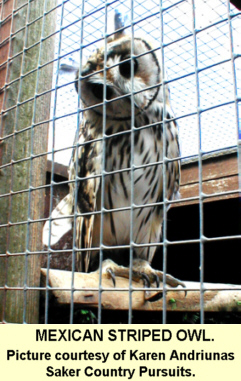
MEXICAN STRIPED OWL.
Asio clamator
IDENTIFICATION. Originally known by the Latin name Rhinoptynx clamator, DNA testing has shown that Striped Owls are in fact related to the group Asio, which includes Long Eared Owls. Striped Owls are divided into 4 subspecies, Asio clamator clamator, Asio clamator oberti, Asio clamator midas and Asio clamator forbesi.
Striped Owls are striking birds. The dark brown eyes are set in a black bordered, pale cream and buff, facial disk. The head is topped with prominent black and gold/buff ear tufts. Black streaking on cream breast plumage adds to this owls striking appearance. The under side of the wings and tail are barred with black.
IN FLIGHT. The flight is similar to that of the Short Eared Owl quartering fields in search of prey. Still hunting from vantage points such as trees is often used.
DISTRIBUTION. Asio clamator forbesi is the Central American race of Striped Owl existing in Southern Mexico through to Panama. The other three species can be found in South America, including Northern Argentina, Uruguay and the islands Trinidad and Tobago. Striped Owls prefer such diverse habitats as open country, savannah, tropical forests and marshes.
FOOD. Generally small mammals to the size of rats. Birds. Reptiles, amphibians and large insects supplement the diet.
BREEDING. December-March. 2 to 4 eggs laid on the ground, like the related Short Eared Owl or in a tree nest. Young hatch after 33 days incubation. Particularly during the breeding season social groups of a dozen or more birds roost together.
SIZE. 33-38 cm (13- 15in)
WEIGHT. 320g-500g (11oz-1lb 1oz)
CALL. Hoots and Barks
FALCONRY.
Not generally used in falconry, but a beautiful owl none the less.
Falconry marks
![]()